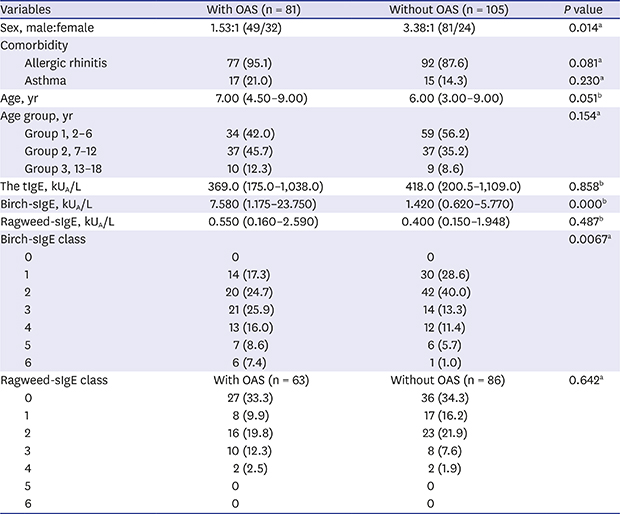1. Ortolani C, Ispano M, Pastorello E, Bigi A, Ansaloni R. The oral allergy syndrome. Ann Allergy. 1988; 61(6 Pt 2):47–52.
2. Webber CM, England RW. Oral allergy syndrome: a clinical, diagnostic, and therapeutic challenge. Ann Allergy Asthma Immunol. 2010; 104(2):101–108.


3. Ma S, Sicherer SH, Nowak-Wegrzyn A. A survey on the management of pollen-food allergy syndrome in allergy practices. J Allergy Clin Immunol. 2003; 112(4):784–788.


4. Skypala IJ, Bull SC, Deegan K, Gruffydd-Jones K, Holmes S, Small I, et al. Prevalence of pollen-related oral allergy syndrome (OAS) in a UK population. J Allergy Clin Immunol. 2010; 125(2):AB218.

5. Canadian society of allergy and clinical immunology annual scientific meeting 2011 quebec, Canada. 20–23 October 2011. Abstracts. Allergy Asthma Clin Immunol. 2011; 7:Suppl 2. A1–A41.
6. Dondi A, Tripodi S, Panetta V, Asero R, Businco AD, Bianchi A, et al. Pollen-induced allergic rhinitis in 1360 Italian children: comorbidities and determinants of severity. Pediatr Allergy Immunol. 2013; 24(8):742–751.


7. Brown CE, Katelaris CH. The prevalence of the oral allergy syndrome and pollen-food syndrome in an atopic paediatric population in south-west Sydney. J Paediatr Child Health. 2014; 50(10):795–800.


8. Ivičević N, Roje Ž, Kljajić Z, Bojić L, Kardum G, Omero L, et al. Prevalence and risk factors for developing oral allergy syndrome in adult patients with seasonal allergic rhinitis. Acta Clin Croat. 2015; 54(1):25–29.

9. Ivković-Jureković I. Oral allergy syndrome in children. Int Dent J. 2015; 65(3):164–168.


10. Bedolla-Barajas M, Kestler-Gramajo A, Alcalá-Padilla G, Morales-Romero J. Prevalence of oral allergy syndrome in children with allergic diseases. Allergol Immunopathol (Madr). 2017; 45(2):127–133.


11. Katelaris CH. Food allergy and oral allergy or pollen-food syndrome. Curr Opin Allergy Clin Immunol. 2010; 10(3):246–251.


12. Cho YS, Lim YJ, Lee JC, Kim SH, Lim MK, Yoo B, et al. Oral allergy syndrome in pollen - sensitized patients. J Asthma Allergy Clin Immunol. 1998; 18(3):458–465.
13. Maeda N, Inomata N, Morita A, Kirino M, Ikezawa Z. Correlation of oral allergy syndrome due to plant-derived foods with pollen sensitization in Japan. Ann Allergy Asthma Immunol. 2010; 104(3):205–210.


15. Geroldinger-Simic M, Zelniker T, Aberer W, Ebner C, Egger C, Greiderer A, et al. Birch pollen-related food allergy: clinical aspects and the role of allergen-specific IgE and IgG4 antibodies. J Allergy Clin Immunol. 2011; 127(3):616–622.e1.


16. Sicherer SH. Clinical implications of cross-reactive food allergens. J Allergy Clin Immunol. 2001; 108(6):881–890.


17. Vieths S. Allergenic cross-reactivity, food allergy and pollen. Environ Toxicol Pharmacol. 1997; 4(1-2):61–70.


18. Amlot PL, Kemeny DM, Zachary C, Parkes P, Lessof MH. Oral allergy syndrome (OAS): symptoms of IgE-mediated hypersensitivity to foods. Clin Allergy. 1987; 17(1):33–42.


19. Kondo Y, Urisu A. Oral allergy syndrome. Allergol Int. 2009; 58(4):485–491.


20. Eriksson NE, Formgren H, Svenonius E. Food hypersensitivity in patients with pollen allergy. Allergy. 1982; 37(6):437–443.


21. Eigenmann PA, Sicherer SH, Borkowski TA, Cohen BA, Sampson HA. Prevalence of IgE-mediated food allergy among children with atopic dermatitis. Pediatrics. 1998; 101(3):E8.

22. Mailhol C, Giordano-Labadie F, Lauwers-Cances V, Ammoury A, Paul C, Rance F. Point prevalence and risk factors for food allergy in a cohort of 386 children with atopic dermatitis attending a multidisciplinary dermatology/paediatric allergy clinic. Eur J Dermatol. 2014; 24(1):63–69.


23. Breuer K, Wulf A, Constien A, Tetau D, Kapp A, Werfel T. Birch pollen-related food as a provocation factor of allergic symptoms in children with atopic eczema/dermatitis syndrome. Allergy. 2004; 59(9):988–994.


24. Liu FT, Goodarzi H, Chen HY. IgE, mast cells, and eosinophils in atopic dermatitis. Clin Rev Allergy Immunol. 2011; 41(3):298–310.


25. Sampson HA. Role of immediate food hypersensitivity in the pathogenesis of atopic dermatitis. J Allergy Clin Immunol. 1983; 71(5):473–480.


26. Kashyap RR, Kashyap RS. Oral allergy syndrome: an update for stomatologists. J Allergy (Cairo). 2015; 2015:543928.

27. Bircher AJ, Van Melle G, Haller E, Curty B, Frei PC. IgE to food allergens are highly prevalent in patients allergic to pollens, with and without symptoms of food allergy. Clin Exp Allergy. 1994; 24(4):367–374.










 PDF
PDF Citation
Citation Print
Print





 XML Download
XML Download